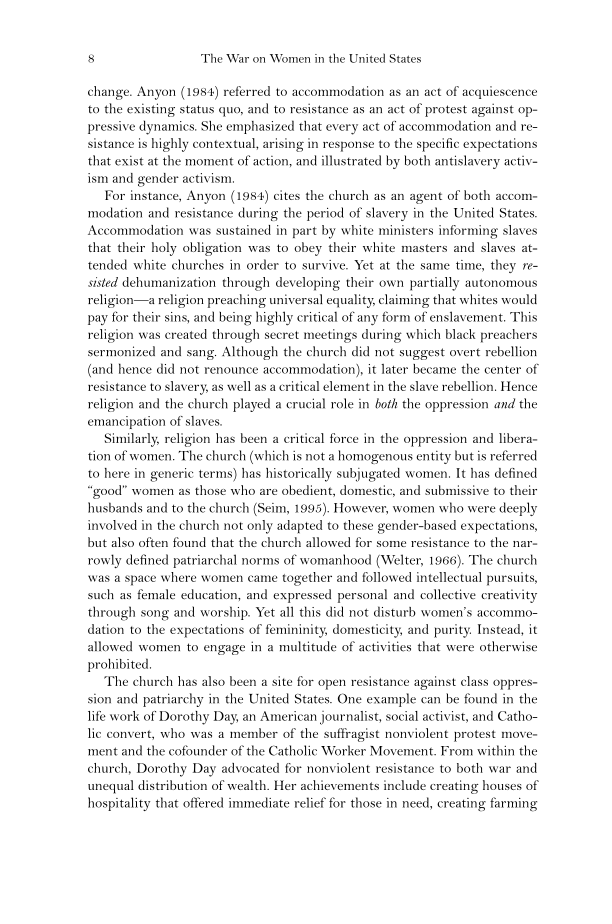8 The War on Women in the United States change. Anyon (1984) referred to accommodation as an act of acquiescence to the existing status quo, and to resistance as an act of protest against op- pressive dynamics. She emphasized that every act of accommodation and re- sistance is highly contextual, arising in response to the specifi c expectations that exist at the moment of action, and illustrated by both antislavery activ- ism and gender activism. For instance, Anyon (1984) cites the church as an agent of both accom- modation and resistance during the period of slavery in the United States. Accommodation was sustained in part by white ministers informing slaves that their holy obligation was to obey their white masters and slaves at- tended white churches in order to survive. Yet at the same time, they re- sisted dehumanization through developing their own partially autonomous religion—a religion preaching universal equality, claiming that whites would pay for their sins, and being highly critical of any form of enslavement. This religion was created through secret meetings during which black preachers sermonized and sang. Although the church did not suggest overt rebellion (and hence did not renounce accommodation), it later became the center of resistance to slavery, as well as a critical element in the slave rebellion. Hence religion and the church played a crucial role in both the oppression and the emancipation of slaves. Similarly, religion has been a critical force in the oppression and libera- tion of women. The church (which is not a homogenous entity but is referred to here in generic terms) has historically subjugated women. It has defi ned “good” women as those who are obedient, domestic, and submissive to their husbands and to the church (Seim, 1995). However, women who were deeply involved in the church not only adapted to these gender-based expectations, but also often found that the church allowed for some resistance to the nar- rowly defi ned patriarchal norms of womanhood (Welter, 1966). The church was a space where women came together and followed intellectual pursuits, such as female education, and expressed personal and collective creativity through song and worship. Yet all this did not disturb women’s accommo- dation to the expectations of femininity, domesticity, and purity. Instead, it allowed women to engage in a multitude of activities that were otherwise prohibited. The church has also been a site for open resistance against class oppres- sion and patriarchy in the United States. One example can be found in the life work of Dorothy Day, an American journalist, social activist, and Catho- lic convert, who was a member of the suffragist nonviolent protest move- ment and the cofounder of the Catholic Worker Movement. From within the church, Dorothy Day advocated for nonviolent resistance to both war and unequal distribution of wealth. Her achievements include creating houses of hospitality that offered immediate relief for those in need, creating farming
Document Details My Account Print multiple pages
Print
You have printed 0 times in the last 24 hours.
Your print count will reset on at .
You may print 0 more time(s) before then.
You may print a maximum of 0 pages at a time.














































































































































































































































































































